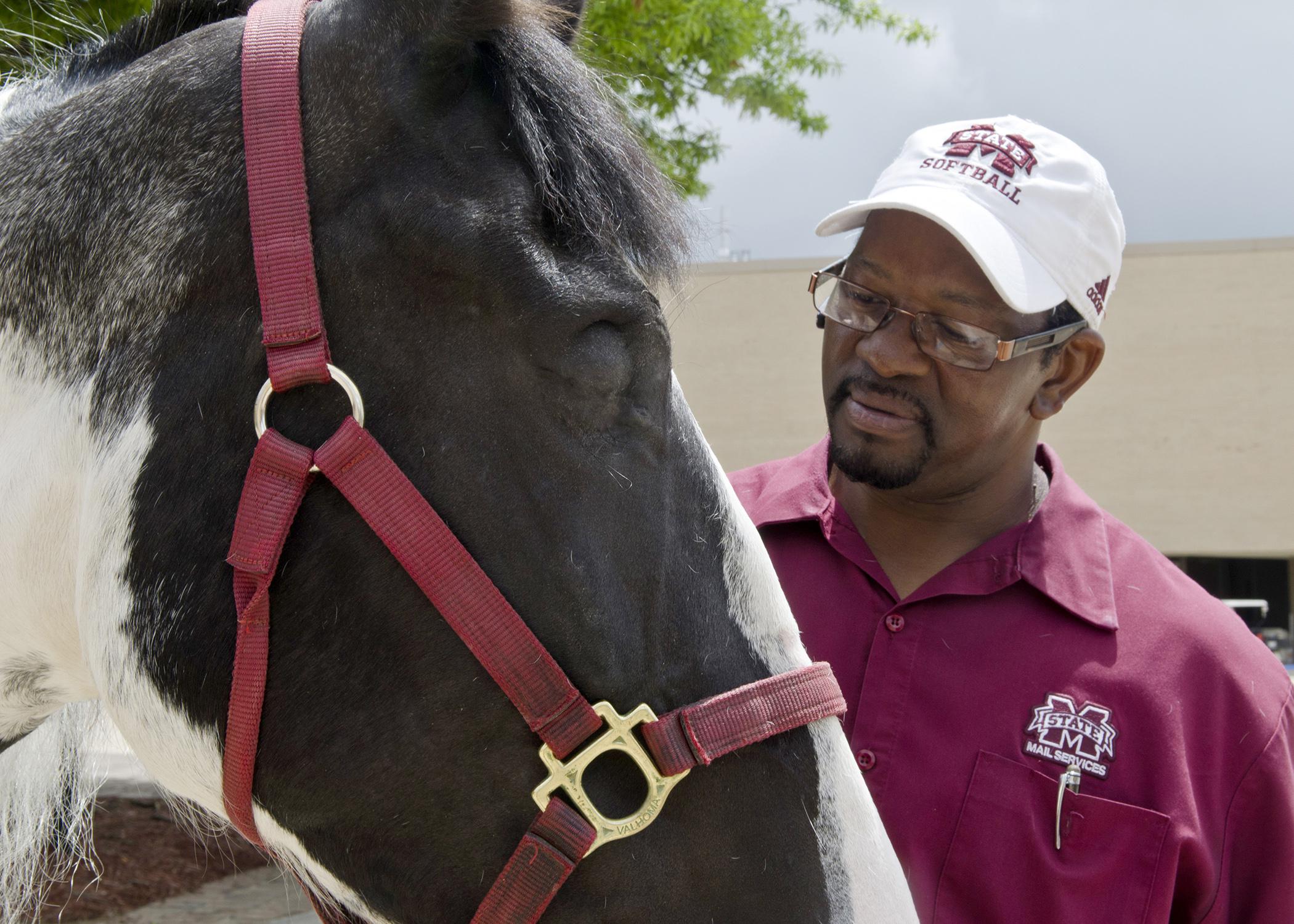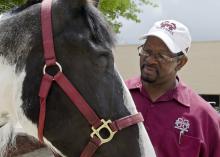Information Possibly Outdated
The information presented on this page was originally released on July 6, 2015. It may not be outdated, but please search our site for more current information. If you plan to quote or reference this information in a publication, please check with the Extension specialist or author before proceeding.
MSU-CVM pioneers equine surgical method
By Karen Templeton
MSU College of Veterinary Medicine
STARKVILLE, Miss. -- When Henry Wilson of Columbus noticed the eye of his beloved horse, Tender, was changing color, he knew something was wrong and did not waste any time getting her to a veterinarian.
“Tender has ridden in a lot of shows and parades and, of course, relies a lot on her good vision,” Wilson said. “In addition to the eye discoloration, she was squinting a lot, and there was discharge around one of her eyes.”
Recognizing that Tender had a serious eye issue, the local veterinarian referred Wilson to the Mississippi State University College of Veterinary Medicine. MSU veterinarians diagnosed Tender with chronic uveitis, an inflammatory disease that causes eye tissue swelling and often leads to blindness.
“Uveitis can be painful, and in the short-term, we can treat the condition with pain and anti-inflammatory medications,” said Dr. Caroline Betbeze, assistant clinical professor of ophthalmology at MSU-CVM. “We were able to manage Tender’s pain with medications, but Tender’s eye was irreversibly blind, and, in those cases, long-term relief is often achieved through removing the affected eye. And that’s what we recommended for Tender.”
Eye removal, called enucleation, relieves the horse of ocular pain, said Betbeze, a board-certified veterinary ophthalmologist.
“The pain is gone after the eye is removed, and, from then on out, the lid remains closed,” she said. “But, for cosmetic purposes, especially in the case of show horses, an orbital prosthesis, essentially a spacer, can be surgically placed under the closed eyelid. It offers facial symmetry and is preferred by many horse owners.”
Betbeze and her colleague Dr. Robin Fontenot, assistant clinical professor of equine surgery, worked together last year to develop a new way to perform this type of procedure.
“For enucleation and prosthesis placement, the horses are typically placed under general anesthesia, and the surgery is performed in a sterile operating room,” said Fontenot, a board-certified equine surgeon. “We wanted to explore a simpler, possibly safer way to do these types of surgeries.”
Fontenot and Betbeze researched the use of a local anesthetic medication that uses simple nerve blocks to prevent pain, rather than full anesthesia. They also created a detailed protocol for cleaning and preparing an equine exam room for a standing surgery. This procedure allows for the horse to be sedated while standing, instead of being placed under general anesthesia while lying down in an operating room. Enucleations are done frequently in operating rooms but not as a standing procedure under local anesthetic.
“We created a checklist of everything that needed to be cleaned and sanitized. The purpose is to get the exam area as clean and safe as the operating room,” Fontenot said. “There’s a certain amount of risk with giving a horse general anesthesia, especially in the induction of anesthesia and recovery to standing from a lying-down position.”
The professors’ goal was to perform the enucleation and prosthesis procedure just as effectively with a standing patient, while also reducing risk. Since December 2014, Betbeze and Fontenot, both MSU-CVM graduates, have performed seven of these surgeries. Tender’s procedure was one of the first.
“She’s been doing great since the surgery,” Wilson said. “I am able to take her on rides, and it is hard to notice that anything had been wrong. I’m so glad we were given this option for helping her. We are really happy with the treatment and care Tender got at Mississippi State.”
In addition to helping patients get relief quickly, the standing surgical procedure provides other benefits.
“General anesthesia and performing this procedure in the operating room is more costly than performing it standing with local anesthesia,” Fontenot said. “Additionally, the horse has a shorter recovery time when we are dealing with a local anesthetic.”
Fontenot and Betbeze report that all patients that have undergone the standing enucleation and prosthesis placement have recovered successfully and have the cosmetic appearance their owners hoped to achieve. The veterinarians said they look forward to treating more patients this same way.
“It’s a great benefit to the horse and the owner with reduced cost and shorter recovery time,” Fontenot said. “It’s great when we can be practical and also reduce risk to our patients.”
Please call 662-325-1351 to make an appointment for your horse, or visit http://www.cvm.msstate.edu to learn more.
Contact: Karen Templeton, 662-325-1100





